5 Weeds 5 Ways
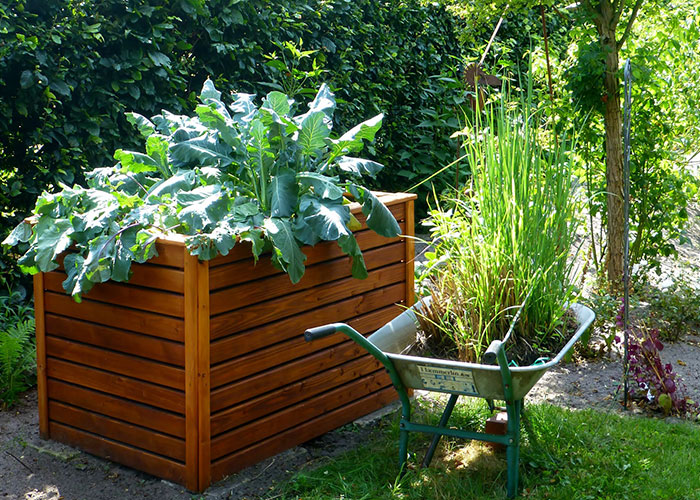
As you prepare your beds for spring planting, you may find yourself yanking out a whole lot of green stuff. From dandelions to shot-weed, uninvited guests proliferate in our gardens before we have even finished sketching out our garden plans.
These hardy wild plants earn their unsavory reputations as “weeds” because they tend to shoulder out the flowers and veggies we plant on purpose. Left to their own devices, they would quickly take over, leaving no space or resources for more delicate crops. A gardener could be forgiven for ruthlessly tossing them in the nearest available green bin.
But we’d like to invite you to take a second look. Not only can these plants provide valuable information, but many of these common “weeds” are better known to herbalists as “spring tonics.” These wild edibles can be delicious when you know how to prepare them, and they are packed with vitamins and other nutrients that can help our bodies recover from the stresses of winter.
Maybe it’s time we reconsidered the term “weeds.” Many of these plants could well be thought of as free, abundant bonus crops. Perhaps the tedious chore of “weeding” could instead be celebrated as the first harvest of the year.
Of course, you’ll want to make sure you’ve identified your plants correctly before you eat them. And although the plants we’ll discuss here are generally considered safe, it’s wise to try any new food in small amounts at first. Make sure to check with a medical professional if you have any questions or concerns.
There are so many simple, easy ways to enjoy your weedy harvest. We’ll get to that in a moment, but first, let’s find out who all we’re dealing with.
5 Spring Tonic Greens
Five of the most common weeds to pop up in local gardens and lawns each spring just happen to be five of the healthiest tonics an herbalist could ask for. How lucky is that? If you have any of these popping up (and most of us have at least two or three of them), then your garden is already full of nutrient-rich spring greens!
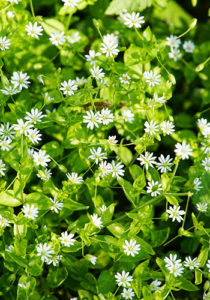
Chickweed (Stellaria media)
Often found growing exuberantly in rich garden beds and in mulch piles, this tender wild green can be recognized by its floppy stems and star-shaped white flowers. If you forgot to plant a cover-crop in your veggie beds last fall, this helpful plant may well have stepped in to volunteer for the job. So as you harvest it, make sure to thank it for protecting your soil over the winter!
While botanists presumably named this plant Stellaria media or “little star” because of its flower shape, it sure does shine bright as a nutritious wild green.
Chickweed is rich in vitamins A and C, as well as a whole host of healthy minerals including iron, zinc, and calcium. It also contains saponins, which are thought to help cleanse and heal internal organs and thereby boost immune function and overall health.
If you tend to develop dry, itchy skin over the winter, chickweed can help with that too! You can mash or chew it and stick it right on the affected spots, blend it with vinegar and add the strained mixture to your bath water, or kick things up a notch and learn how to concoct a homemade salve.
If you are new to harvesting & eating wild greens, this is a great one to start with. The texture is soft and succulent like spinach, and the flavor is mild if perhaps just a bit “grassy.” Its delicate stems and shallow roots make it a breeze to harvest.
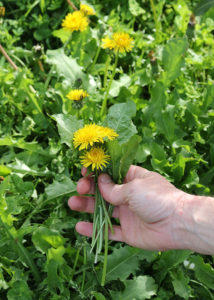
Dandelion (Taraxacum officinale)
As one of the most ubiquitous and also flashiest weeds around, dandelion is likely among the first wild plants most of us ever learned to recognize. It’s hard to miss those sunny yellow flowers! Picking out the rosettes of leaves early in the spring can take a little more practice, but you’ll notice them everywhere once you start looking for them.
These weeds are notorious for their deep tap roots that make them difficult to fully remove. But here’s another perspective: those tap roots create valuable space for air and water to penetrate the compacted soils that dandelions seem to prefer, and they pull nutrients up from deep underground.
Every part of the dandelion is nutritious and medicinal. If you have just yanked out a whole bunch and feel adventurous, you might want to try roasting the roots and brewing them up as an earthy-tasting coffee substitute.
But if you want to stick with the fresh greens for now, those have plenty to recommend them too. They are rich in vitamins A, B, and C, and they’re full of trace minerals too.
If you love bitter greens like arugula and radicchio, you may enjoy the distinctive bite of dandelion greens. Try them raw in salads, or simply sauteed and served with salty cheese. If you find the flavor a bit overpowering, you can stick to uses such as teas sweetened with honey or smoothies with plenty of sweet fruit. Younger leaves tend to be milder than larger ones, and all of the leaves will be milder early in the season than later on.
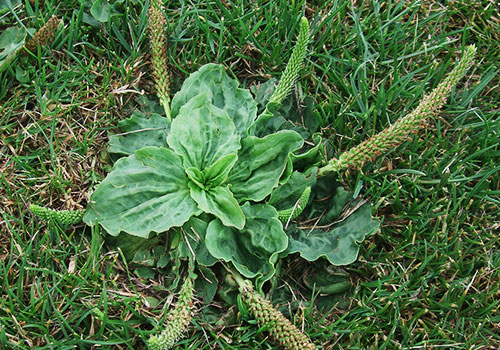
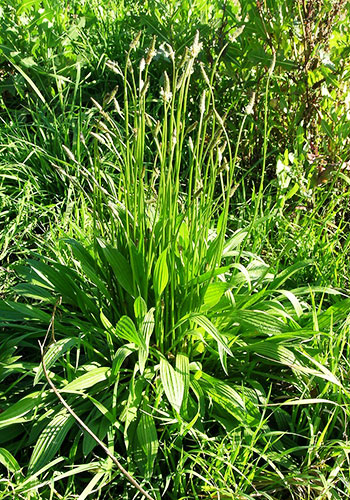
Plantain (Plantago major & Plantago lanceolata)
Have you ever stopped to take notice of these common weeds? You might find them in your garden beds, lawn, or gravel driveway. They might not look like much, but they’re packed with nutrients and healing potential. Both common species of plantain (pictured above) share similar benefits.
The multitude of nutrients this plant has to offer include vitamins B, C, and K, along with more starch and protein than most greens. Herbalists value its gentle soothing and antihistamine properties, and include it in remedies for spring allergies. Externally, crushed plantain is great for reducing the pain and itchiness of insect stings and for drawing out slivers — great uses for active gardeners to keep in mind!
The mild flavor of this one is nothing to write home about, but at least it’s not overwhelming. The seeds can also be used. Psyllium seed comes from the seeds of a specific variety of plantain.
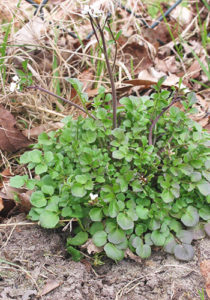
Hairy Bittercress
(Cardamine hirsuta)
Even if you don’t recognize the name, you will almost certainly recognize this picture.
Aptly nicknamed “shotweed” because of the way it exuberantly flings seeds all over the place, hairy bittercress is nearly as ubiquitous as dandelions in most gardens. And when it’s viewed as a weed to be removed, it can be extremely frustrating! It seems to pop up everywhere, and it often flowers and goes to seed faster than it can be pulled.
Of course, with a shift of perspective, that “problem” can become a gift: all the wild greens you could ask for, and all you have to do is go harvest them.
Hairy bittercress could well be considered the most delectable weed on this list! It is a close cousin of arugula and mustard greens, and it shares a similar peppery zest. It boasts all kinds of great nutrients, including vitamin C, calcium, magnesium, and antioxidants. The leaves are especially tender before it flowers, but all parts of the plant are edible.
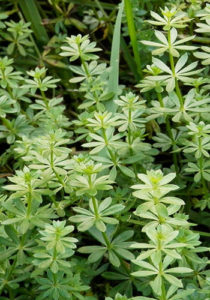
Cleavers (Galium aparine)
You may know these as the scraggly, stringy weeds that stick to your clothes and hair if you walk through an overgrown spot in the summer. Did you know you can eat them? Did you know you might even want to? Early in the season, they are much less tough and sticky and much more delicious.
Cleavers are best known for cleansing and supporting the lymphatic system and are good as a tea. Essentially, they can help our bodies clear out toxins and keep everything running smoothly.
It's best to use in the spring before the plant blooms and develops the sticky seed pods.
5 Ways to Enjoy the Harvest
You don’t need any expensive equipment, specialized training, or even a specific recipe to use these spring tonics. In fact, they can be prepared just like any other herbs or greens!
Keep in mind that wild greens tend to have strong flavors to go with their high nutrient contents. You can feature them like you would other bold greens, or you can use them more sparingly like fresh herbs. It all depends on your palate and preferences.
Here are five simple, easy ways to take your spring tonics:

Salad
If you’re making salad anyway, why not include whatever wild greens you just pulled out of your veggie patch? If you aren’t sure about the idea of a whole mouthful, just chop them up small and mix them in with milder greens and sweet veggies. To make it a meal and further balance flavors, you could also add hearty ingredients like croutons, beans, fried tofu, boiled eggs, meat, or cheese. The wild greens will add an extra boost of both flavor and nutrition.
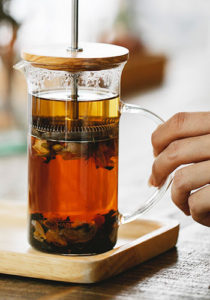
Herbal Tea
Fun fact: the result of steeping any plant other than Camellia sinensis in hot water is technically called a “tisane” (tea-zahn) So please feel free to call your concoctions “spring tonic tisanes” if you want to feel fancy! Tisanes can be made from either fresh or dried greens. Steep your greens in hot water for at least 10 minutes and then strain out the greens and enjoy. Add your favorite store-bought herbal tea, or combine with dried lavender or mint to make your tisane even more delicious.
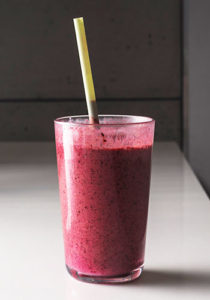
Smoothies
Make your own “green smoothie” with extra-nutritious wild greens! This is a particularly great way to take your spring tonics if you don’t love their natural textures or flavors. Just toss a big handful in your blender along with whatever other fresh or frozen ingredients you like! If you aren’t an experienced smoothie-maker, here are a few ideas:
- You need liquid to help it all blend smoothly. All kinds of milk (whether from an animal or a plant) are tasty, and they add protein too. You can also use juice, or even water in a pinch. If the mixture seems stuck, add more liquid and stir.
- Bananas and avocados add a lovely, smooth texture and are great for bulking up your smoothie without overpowering other flavors.
- The sweet-tart flavors of berries and citrus are strong enough to mask any bitter flavors from your greens.

Soup
Soups are great for warming up after chilly early-spring gardening, so why not toss in some weeds? These can be subbed in for kale, arugula, or spinach in just about any soup recipe. You could even whip up a very basic soup using just your stock of choice, whatever potatoes and other veggies you have on hand, leftover meat or tofu, and wild greens. Young dandelion and plantain leaves can be roughly chopped. From a texture standpoint, you might want to chop cleavers, chickweed, and bittercress, along with any older dandelion or plantain leaves more finely so that they integrate into the dish.

Pesto
Of course, classic pesto is made with ephemeral basil and pine nuts. But combining any combination of flavorful greens, nuts, and oil, along with other ingredients like garlic and aged cheese if you like, can yield a delicious and nutritious variation. If you don’t already have a favorite recipe of your own, you could try this one.
Consider Before You Compost
These five common spring tonic weeds are just a few of the many wonderful wild foods and medicines growing right outside our doors. By viewing each plant as a unique individual with its own nutrients, knowledge, and other benefits to offer, we can move beyond just dividing plants into “weeds” vs. “crops.” Remember that a weed is just a plant you find inconvenient. Perhaps the only way to truly eradicate “weeds” is to reimagine them so that such a negative term no longer applies.
